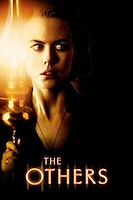The Others
Alejandro Amenábar, USA, Spain, 2001o
The English island of Jersey in 1945: pious Grace, whose husband has still not returned from the war, lives with her two children Anne and Nicholas in the eternal semi-darkness of a sprawling Victorian house because both children are allergic to sunlight. When the family begins to suspect that the house is haunted, Grace imposes a series of strict rules on the family and their three new servants in order to protect the children.
Are these signs of increasing madness when the pious mother and presumed war widow Grace raises her children behind closed curtains because of a supposedly life-threatening sun allergy and immediately instils a series of bizarre house rules in three new servants? And is her rebellious ten-year-old daughter driven by mischievous whims when she claims to her mother and little brother that the house is haunted and that she is visited at night by a strange boy? The chilling story The Others, with which Spanish shooting star Alejandro Amenábar definitively entered the international stage at the age of 29 and confirmed his exceptional talent as a scenarist, composer and director, revolves around such questions. The Others is set in a gloomy Victorian mansion on the English Channel Island of Jersey in 1945, where Amenábar situates his story perfectly between maternity drama, classic creepiness and modern mystery thriller, allowing it to constantly oscillate between the eerily beautiful and the downright sinister. He completely dispenses with the gory shock effects of the horror genre and works, as aesthetically as economically, only with music and sounds, twilight and cuts in which supposed terror turns into sadness and a longing for comfort. His entire small ensemble plays with this tipping point effect to great effect, especially Nicole Kidman, whose character's first name is not coincidentally reminiscent of the cool beauty of Grace Kelly while she vibrates like Ingrid Bergman in Gaslight. Finally, the questions posed at the beginning are answered in a completely different way than expected and allow the film to appear in a completely new light. As I said: eerily good!
Andreas Furler

